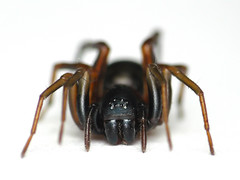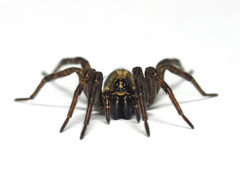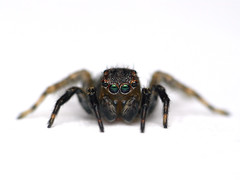click for large
Fishing spiders are similar to the larger wolf spiders in size, shape, and coloration. Species in the genus Dolomedes are called fishing spiders because most live near water and have been reported to catch small fishes and aquatic insects from the water as they walk on the surface. The species Dolomedes tenebrosus is more frequently associated with wooded areas (it would be more accurately classified as a tree-dwelling spider) and is a common household invader in these locations. It occurs from New England and Canada south to Florida and Texas.
I found this one on a river bank while I was catfishing. I caught this one, but missed a larger one when it dropped down into the water and ran away downstream. They can really move like lightning!
D. tenebrosus is a fairly large spider. The females are 15 to 26 millimeters in length; males are 7 to 13 millimeters. Both sexes are brownish-gray in color with black and lighter brown markings.
Dolomedes tenebrosus are frequently found far away from water, usually in wooded settings. They hibernate as immature adults (penultimate instar) under stones or loose bark, in tree cavities, and in human-made structures. D. tenebrosus matures in the spring and will subsequently mate. Mature individuals may be found from early May through September. The egg cases are deposited in June and are carried around by the females until the spiderlings are ready to hatch. Young spiderlings may be found from July through September. The young are guarded by the female in a nursery web and may number 1,000 or more.
Raynox DCR-150 mounted on my Panasonic FZ8.
mounted on my Panasonic FZ8.
I found this one on a river bank while I was catfishing. I caught this one, but missed a larger one when it dropped down into the water and ran away downstream. They can really move like lightning!
D. tenebrosus is a fairly large spider. The females are 15 to 26 millimeters in length; males are 7 to 13 millimeters. Both sexes are brownish-gray in color with black and lighter brown markings.
Dolomedes tenebrosus are frequently found far away from water, usually in wooded settings. They hibernate as immature adults (penultimate instar) under stones or loose bark, in tree cavities, and in human-made structures. D. tenebrosus matures in the spring and will subsequently mate. Mature individuals may be found from early May through September. The egg cases are deposited in June and are carried around by the females until the spiderlings are ready to hatch. Young spiderlings may be found from July through September. The young are guarded by the female in a nursery web and may number 1,000 or more.
Raynox DCR-150






